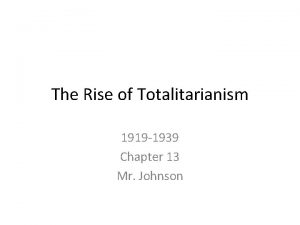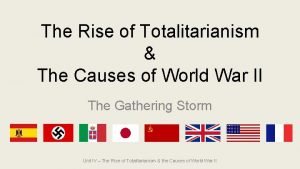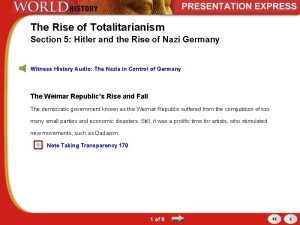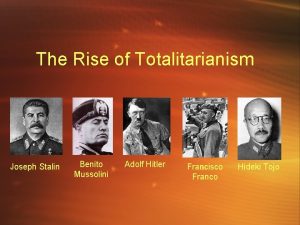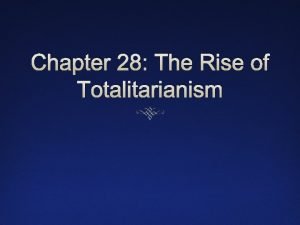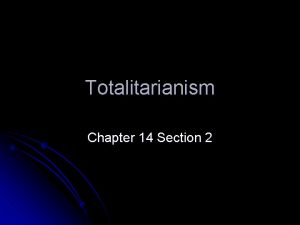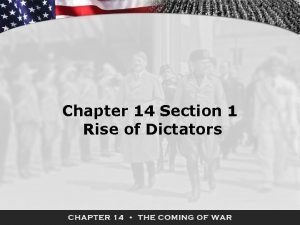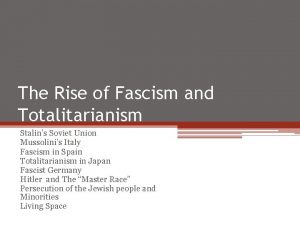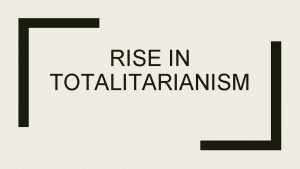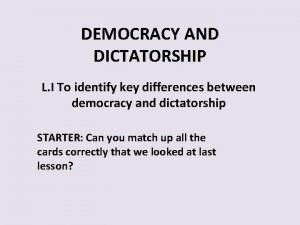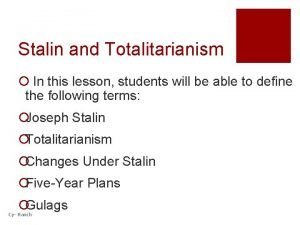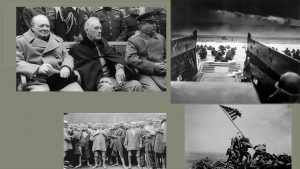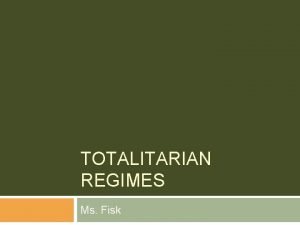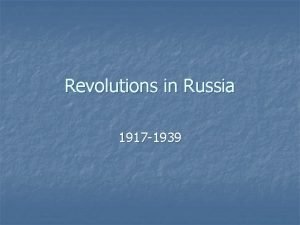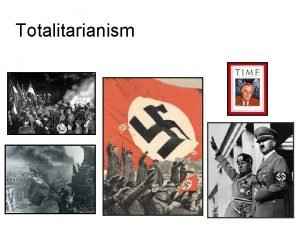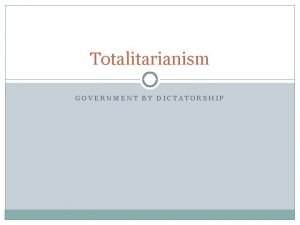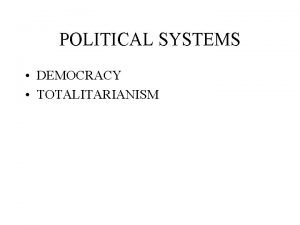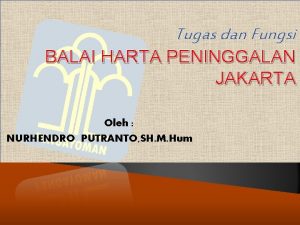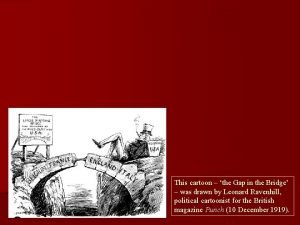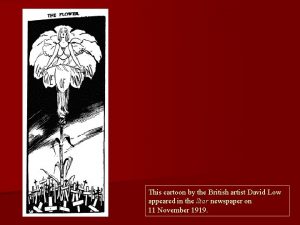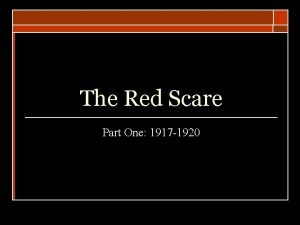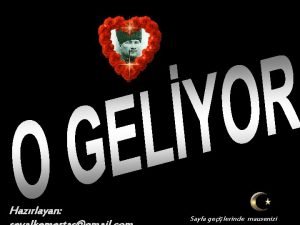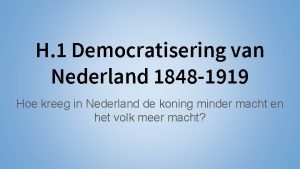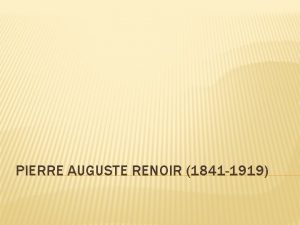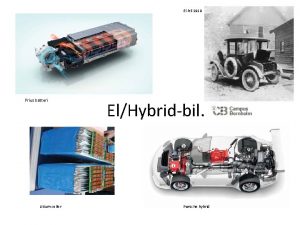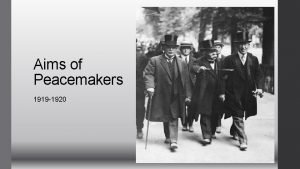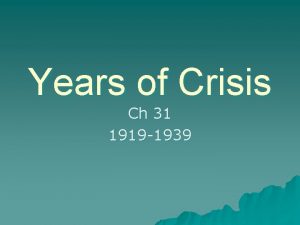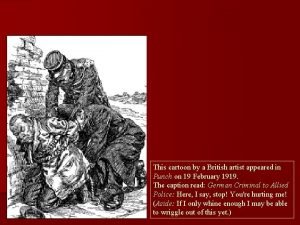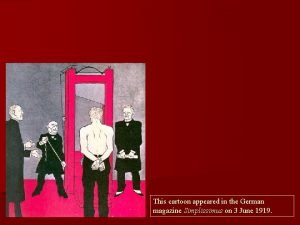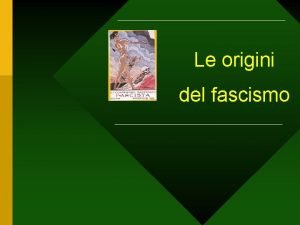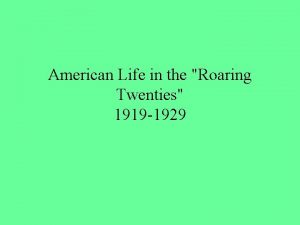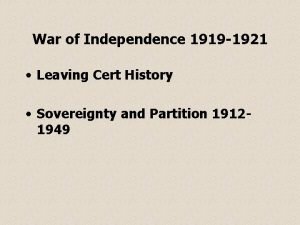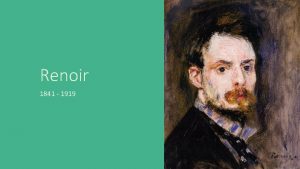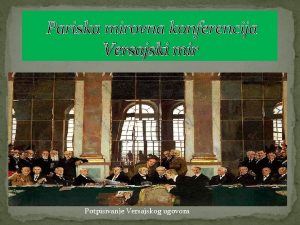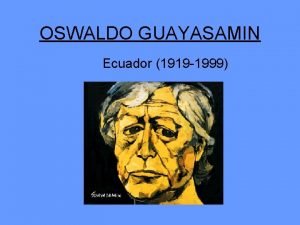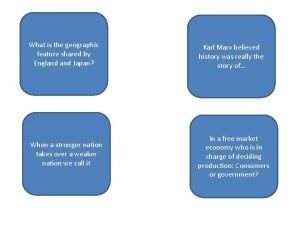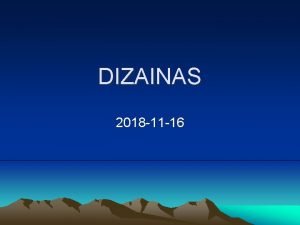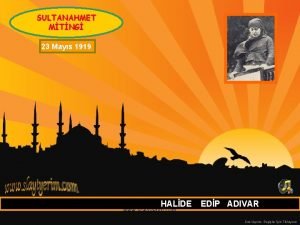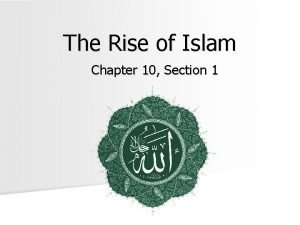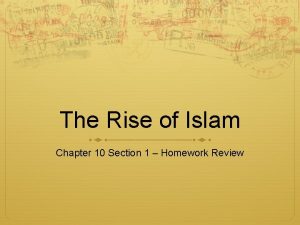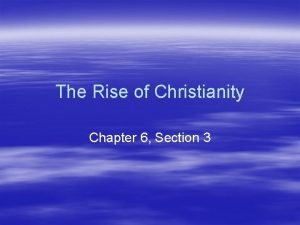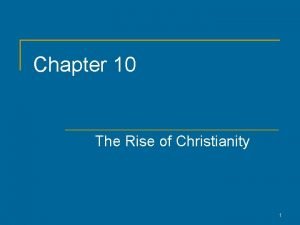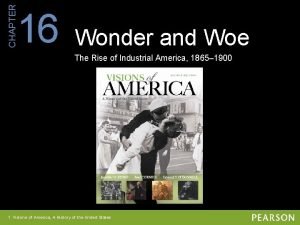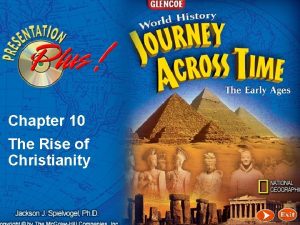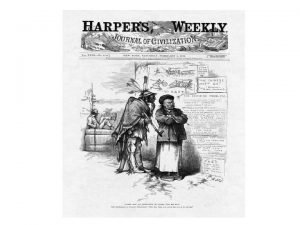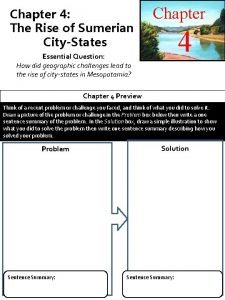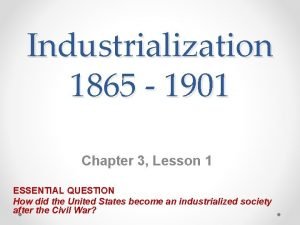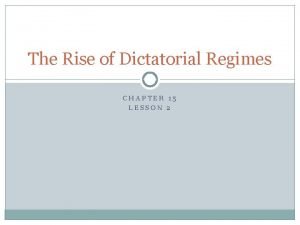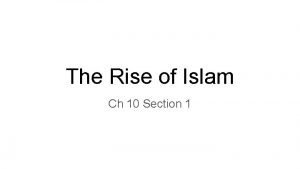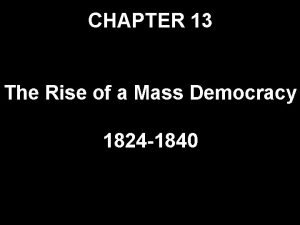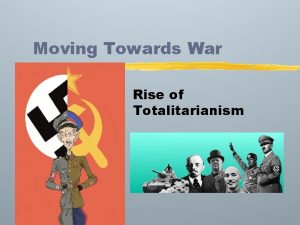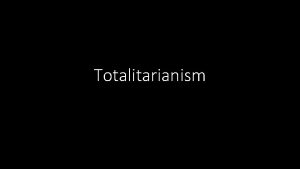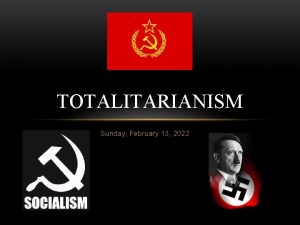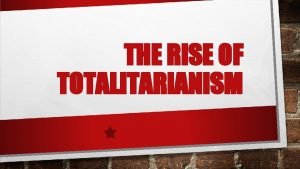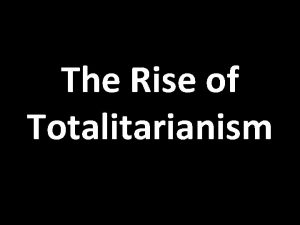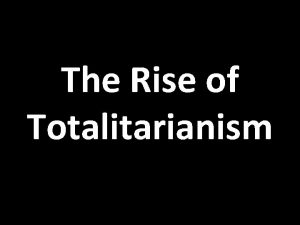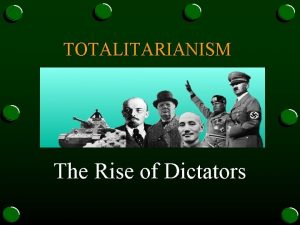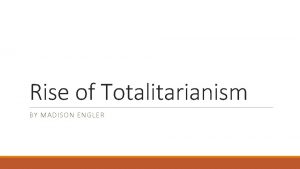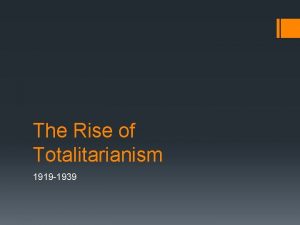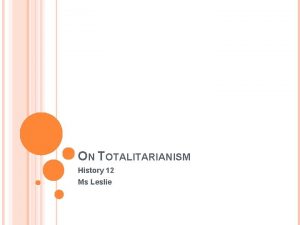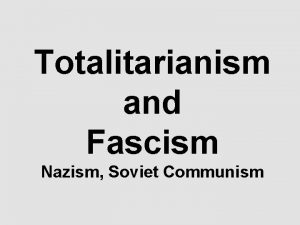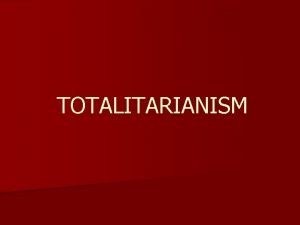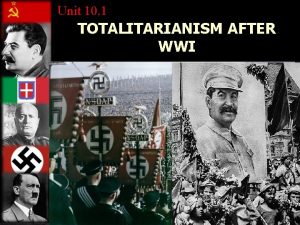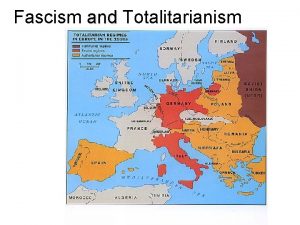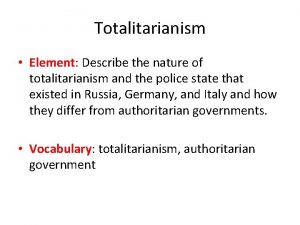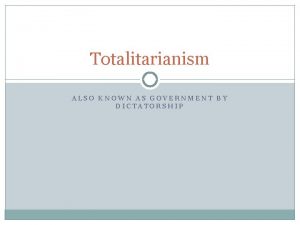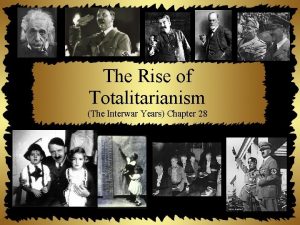Chapter 16 Overview The Rise of Totalitarianism 1919














































































































- Slides: 110

Chapter 16 Overview The Rise of Totalitarianism 1919 -1939 • Totalitarianism- governments total control over citizens public and private lives Ø This type of government was on the rise during 1919 -1939 Ø Why do you think people were willing to accept totalitarian leaders and government? • Chapter Objective-What political and economic challenges did the Western World face in the 1920’s and 1930’s and how did carious countries react to these challenges? Topics we will cover in Chapter 16: Postwar Social Changes World Depression and problems with western democracies Rise of Fascism in Italy All are Rise of Stalinism in Russia totalitarian Rise of Nazism in Germany governments Rise of Militarism in Japan (chapter 15 section 5)

Chapter 16 Section 1 Postwar Social Change

Objectives • Analyze how Western society changed after World War I. • Explain how some people reacted against new ideas and freedoms. • Describe the literary and artistic trends that emerged in the 1920 s. • List several new developments in modern scientific thought.

Terms and Places • flapper – young woman who rejected the moral values of the Victorian era in favor of new, exciting freedoms • Prohibition – a ban on the manufacture and sale of alcoholic beverages in the United States • speakeasies – illegal bars where alcohol was served during Prohibition • Harlem Renaissance – African American cultural awakening

Terms and Places (continued) • psychoanalysis – a method of studying how the mind works and treating mental disorders • abstract – a form of art composed of lines, colors, and shapes, sometimes with no recognizable subject • dada – artistic movement that rejected all traditional conventions • surrealism – an art movement that attempted to portray the workings of the unconscious mind

What changes did Western society and culture experience after World War I? Society and culture were shaken by the experience of the war. This reaction occurred in Europe, the United States, and many other parts of the world. In science, discoveries changed what people understood. These shifts were mirrored in music, literature, and the fine arts. The world had changed, and the culture that existed before World War I no longer seemed to fit this new world.

During the 1920 s, new technologies changed the way people lived in the world. • Affordable These included: • Improved • Motion cars telephones pictures • Radio These advances helped create a mass culture. • Labor-saving devices such as washing machines and vacuum cleaners

Jazz emerged in the United States in the 1920 s. • This new form of music combined Western harmonies with African rhythms. • Nightclubs and the sounds of jazz became symbols of freedom. • Jazz attracted young people who rejected Victorian values. The 1920 s became known

Women enjoyed new opportunities • As a result of their war work, women in many Western nations won the right to vote. • More woman worked outside the home and more careers opened up for women. • Labor-saving devices gave women more leisure time. • Flappers, French flappers model the new shorter who embraced jazz and new freedoms, became a symbol of rebellion against Victorian values.

Some people reacted against new freedoms and ideas. Many Americans favored Prohibition. A constitutional amendment in 1919 banned alcohol. Under Prohibition, organized crime and speakeasies flourished. The amendment was repealed in 1933. A rising Christian fundamentalist movement supported traditional values and ideas about the Bible. John T. Scopes was convicted of breaking a Tennessee law that banned teaching Darwin’s theories about evolution.

Postwar literature had a different focus than Victorian writings. • Wartime experiences led some authors to portray the modern world as spiritually barren. Writers such as Ernest Hemingway and F. Scott Fitzgerald were dubbed the “lost generation. ” • Writers such as James Joyce and Virginia Woolf experimented with “stream of consciousness, ” portraying the workings of the inner mind without imposing logic or order.

Postwar literature had a different focus than Victorian writings. • African American writers of the Harlem Renaissance expressed pride in their unique culture.

New artistic movements rejected realistic representation of the world. • Abstract art focused on lines and colors rather than recognizable subjects. • Dadaism sought to upset traditional conventions by using shocking images. • Surrealism attempted to portray the inner workings of the mind. An abstract painting by Russian artist Vasily Kandinsky

Scientific discoveries changed the world and challenged some long-held ideas. • Marie Curie, Albert Einstein, and Enrico Fermi increased understanding of the atom. Their work would later lead to the development of atomic energy and nuclear weapons. • Alexander Fleming discovered penicillin, the first antibiotic, which is used to combat many diseases • Austrian psychologist Sigmund Freud introduced new theories about the unconscious mind. His use of psychoanalysis changed perceptions of the mind.

Scientific discoveries changed the world and challenged some long-held ideas. • Austrian psychologist Sigmund Freud introduced new theories about the unconscious mind. His use of psychoanalysis changed perceptions of the mind.

Summary The trauma of World War I propelled many people to change the way they thought and acted during the turbulent 1920 s. • Science, medicine, politics, art, music, and architecture drove this evolution. • At the end of the 1920 s, the “lost generation” would face a new crisis in the form of a worldwide economic depression.

Today • Announcements • Go to the library to work on totalitarian projects-YOU HAVE 30 MINUTES to work on them. • Present countries • Preview next week’s lesson

Chapter 16 Section 2 Western Democracies Between the Wars Also see your 16 -2 book notes for this section

Objectives • Summarize the domestic and foreign policy issues Europe faced after World War I. • Compare the postwar economic situations in Britain, France, and the United States. • Describe how the Great Depression began and spread and how Britain, France, and the United States tried

Terms and People • Maginot Line – massive fortifications built by France along its German border • Kellogg-Briand Pact – an agreement to renounce war as an instrument of national policy • disarmament – the reduction of armed forces and weapons • general strike – a strike by workers in many different industries at the same time

Terms and People (continued) • overproduction – the situation that exists when production of goods exceeds demand • finance matters – management of money • Federal Reserve – the central banking system of the United States • Great Depression – a time of global economic collapse

Terms and People (continued) • Franklin D. Roosevelt – elected President of the United States in 1932 • New Deal – a massive package of economic and social programs introduced by FDR

What political and economic challenges did the leading democracies face in the 1920 s and 1930 s?

Post WWI Problems • Weak governments-democracies lacked experience and people were frustrated • Lack of _________ • Desperate people • __________ • US economic failure-The Great Depression • Businesses go down ________

Unstable Democracies • After WWI many European Governments were weak and absolute rulers were overthrown. • People had little experience in participating in a democracy • Temporary governments (_______governments) took over and could not deal with-rebuilding and debt issues from WWI. • Frequent changes in government made it hard for strong leadership to develop. This led to the acceptance of strong leaders.

Coalition Government Issues/parties • Labor Party-unions and reforms for Workers • Socialist Party- make reforms and give out relief for the poor • Reparations Party-collect reparations from Germany now • Communist party-government take control of all property and redistribute equally • Peace Party-work together with other nations. Lessen Treaty of Versailles rules.

Problems with the Weimar Republic • Germany’s new _______ post WWI • No democratic tradition in Germany • Millions of Germans blamed this government for defeat in WWI and for signing the ____________ • _______-the dollar value in Germany was worthless. The Germans printed more money to deal with reparations owed after WWI.

Post War Europe-Economic Problems • Many countries did not raise _______ to pay for war • Germany just printed more money to pay for debts resulting in massive inflation. Example- In Berlin, a loaf of bread cost less than one mark in 1918, over 160 marks in 1922 and over 200 billion by 1923.


U. S. Financial Collapse by 1929 • Un = distribution of wealth between rich and poor • Overproduction by business and agriculture -caused prices to go down • Americans were buying less • People could not pay off debts to banks • Banks then failed with no money coming in • Stock Market Crashed as companies and investors were losing money

Worldwide Depression • American bankers demanded payment of loans from other countries • Investors withdrew their money from Europe • People in Europe could not afford to buy products due to unemployment • Countries were still trying to pay for WWI • High tariffs were imposed. • Tariff-tax on imported goods.

World Depression • US financial collapse set off world depression • Each country tries to solve their economic problems • Many countries maintain democracy but make more socialistic reforms (example-New Deal Programs in US) • Other countries look to dictators to solve their problems-Hitler,

Democracy in Britain and France in m is d sc an y Fa aly an It erm G Co m in m Ru un el an ss ism se d ia w he re Three governmental systems competed for influence in postwar Europe. With the Great Depression and the difficulties that faced the Western democracies, other nations looked to fascist leaders for guidance.

The Great Depression caused many people to lose faith in the ability of democratic governments to solve problems. Some European nations turned to authoritarian leaders who promised to restore order and prosperity. Unemployed men in Britain take part in a “hunger march. ”

Chapter 16 Section 2 -Western Democracies Face Problems • • Britain Political parties fought • over supporting middle class business interests (Conservative Party) or workers rights (Labor Party) • Massive strikes occurred-general strike Britain lost control of its colony Ireland-only • the Northern part of Ireland remains part of the UK Favored loosening restrictions over Treaty of Versailles • towards Germany France Government in France (Third Republic) was weak and plagued with political divisions and financial scandals Had differing views on how to get Germany’s war reparations Feared German invasion so they set up a series of forts on the border called the Maginot Line Wanted strict punishment of Germany under the Treaty of Versailles Most countries post WWI: • Struggled economically • Favored international peace and working together-Kellog-Briand was signed and countries agreed to renounce war to get what they wanted from other countries and agreed to disarmament (reducing their armies) • • US Was in good shape financially after the WWI Feared foreigners in their country especially from Russia (Red Scare) People didn’t want immigrants bringing in communist ideas due to the communist revolution that occurred in Russia Favored loosening restrictions of Treaty of Versailles towards Germany By 1929, US economic prosperity collapsed due to: low demand overproduction of goods this leads to unemployment (25%), stock market crashed, Federal Reserve increased the interest rate making borrowing difficult, US banks stopped loaning money, tariffs were raised and other countries responded by raising theirs, world trade dropped which increased unemployment • • • Germany Germans hated the democratic Weimar Republic government for signing the Treaty of Versailles Germany was forced to pay reparations but struggled due to loss of land colonies Inflation caused major problems in Germany and the value of their money decreased The US helped Germany recover their money by sending $ 200 million dollars to them under the Dawes Plan US made loans to German businesses to help spark the economy

Today-Objectives • Recall concepts from section 1 and 2 by playing Kahoot • Understand how conditions post WWI led to the rise of totalitarian governments • Understand the principles of a totalitarian government • Create a fictional totalitarian country in groups.

Totalitarianism-total control of citizens public and private lives • • • Totalitarian government started in Italy during the 1920’s and other countries followed suit People accepted these governments because they promised help and a strong country again when people were in the midst of suffering economic depression Democracies world wide were weak and people needed strong leadership Totalitarian governments use six principles to control their citizens and maintain absolute power: __________-use of fear and force to intimidate and control citizens __________ – brainwashing or using tactics to mind control citizens into believing the leader/political party is the best ___________- use of advertisements or media to promote only good things about a leader or party. Ex-billboards showing Hitler reading to children, books about Hitler’s heroics in WWI, radio broadcasts about a leader or newspapers that only report good things about the government ___________-limiting information that people see through the media-newspapers, tv, radio, internet, cell phones. You block access to differing opinions or other ways of life. ___________-discriminating or killing off of a religious group or, you allow no religion at all. The leader and country must come above all else ___________-singling out one or more ethnic groups who do not match up with a supreme race. Ex. The Jews in Nazi Germany were separated from society in Ghettos and eventually killed.

Rise of Totalitarian Governments • Dictators will take over in Italy, Germany, Russia and Japan • The rest of Chapter 16 explains how totalitarianism rises in each country • Italy-Fascism • Germany-Nazism • Russia-communism • Japan-Militarism-control by the head of military officials

Chapter 16 Section 3 Fascism in Italy

Terms and People • Benito • Black Mussolini – Fascist leader of Italy Shirts – Fascist party militants • March on Rome – a rally of tens of thousands of Fascists who marched on Rome in 1922 to demand government changes • totalitarian state – a one-party dictatorship that regulates every aspect of the lives of its citizens

Terms and People (continued) • fascism – any centralized, authoritarian government that is not communist whose policies glorify the state over the individual and are destructive to basic human rights

How and why did fascism rise in Italy?

Fascism Rises in Europe • Many people lost faith in democratic governments during the world wide depression • People favored an extreme form of government to take control and solve problems • Fascism-a new, militant political movement that emphasized loyalty to the state and obedience to its leader.

Characteristics of Fascism-Section 3 • Extreme nationalism • Pledge loyalty to your leader • Fascist wore uniforms of a certain color, had special salutes, held mass rallies • No belief in equality, every class had a purpose • Most fascists were aristocrats and industrialists, war veterans and lower middle class • Government controls economy

Problems for Italy Post WWI • Citizens were angry with treaty of Versailleswanted more territory in the Balkan region but this went to make up Yugoslavia • People felt like they fought in WWI for no reason • Unemployment was high • Trade was low and the economy suffering • Violence and strikes were breaking out • Veterans of WWI were especially angry with


Rise of Fascism Italy • Dictator Benito Mussolini created the first fascist government (fascist party founded in 1919) • The Italian democratic government was not solving the countries problems-corruption rampant • Benito Mussolini promised the people to rescue the economy and make Italy strong. • Mussolini began gathering follower(WWI vets and middle class business men) • Created the Fascist party-Latin for bundle of sticks wrapped around an ax-means unity

Rise of Fascism cont… • Mussolini created the Black Shirts which were party militants who used violence to control parts of Italy • Black shirts crushed political rallies, destroyed press that they did not agree with (socialist or leftist), rigged elections and used fear and intimidation to control people/elections

Mussolini takes control • October 1922 30, 000 fascists marched on Rome • King Victor Emmanuel III put Mussolini in charge of government in an attempt to save his position as the monarch • Mussolini “legally took power” • Mussolini was call Il Duce meaning leader • Took away democracy and outlawed all political parties • Opponents were jailed • Radio and newspapers were censored • Economy was directed by him by allying industrialists and land owners

Mussolini preserved capitalism, but took control of the state. He favored the wealthy at the expense of the workers. • Men were urged to be selfless warriors fighting for Italy. To Fascists, the glorious • Women were pushed out state was of paying jobs to bear all-important. more children. • Children were taught to obey strict military

For many in Italy, fascism promised a strong stable government and an end to the political feuding. Mussolini projected a sense of power and confidence that was welcome amid the disorder and despair of postwar Italy. Once Mussolini embarked on foreign conquest, Western democracies protested.

Propaganda Slogans Believe! Obey! Fight! “Win the battle of motherhood!” Women who had 14 or more children were personally awarded a medal by Mussolini

Fascists Communists Pursued nationalist goals Worked for international change Supported a society with defined classes Spoke of creating a classless society Blind devotion to the state Used terror for power Flourished in economic hard times Rule by an elite

Summary • Mussolini rose to power during a chaotic time in Italy • Citizens were angry over the treaty of Versailles • Many revolutions occurred-communists, socialist • Mussolini formed a party and had force through the Black Shirts • They were extreme nationalists who took over Italian government by 1922. • The King of Italy granted Mussolini the power b/c he feared civil war if not

The next totalitarian leader to rise to power was Joseph Stalin…

Hitler and Stalin, the rise of evil • https: //www. youtube. com/watch? v=HR 5 Sn_x z 9 HQ

The Soviet Union Under Stalin Chapter 16 Section 4

Objectives • Describe the effects of Stalin’s fiveyear plans. • Explain how Stalin tried to control how people thought in the Soviet Union. • List communist changes to Soviet society. • Outline Soviet foreign policy under Stalin.

Terms and People • command economy – an economy in which government officials make all basic economic decisions • collectives – large farms owned and operated by peasants as a group • kulaks • Gulag – wealthy farmers – brutal labor camp

Terms and People (continued) • socialist realism – an attempt to show Soviet life in a positive light and promote hope in the communist future • russification – making a nationality’s culture more Russian • atheism god – the belief that there is no • Comintern – a communist group whose purpose was to encourage worldwide revolution

How did Stalin transform the Soviet Union into a totalitarian state? After the death of Lenin in 1924, Stalin began his plan to ruthlessly control the Soviet Union and its people. Through a series of five-year plans, forced labor, and forced collectivization, Stalin transformed the Russian communist vision to that of a totalitarian state.

The Soviet Union under Stalin became a totalitarian state controlled by a powerful and complex bureaucracy. In 1928, he imposed the first of several “fiveyear plans” to: • Build up heavy industry • Improve transportation • Increase output farm

Stalin increased government control By bringing all economic activity under government control, Stalin created a command economy. By contrast, in a capitalist system, the free market determines most economic decisions.

Between 1928 and 1939, the Soviet Union experienced tremendous growth in industry. The government: • Built large factories • Built hydroelectric power stations • Created huge industrial complexes • Improved oil, coal, • Expanded mining and steel production • Built new railroads

Although Stalin’s five-year plans built industry, overall the standard of living remained low. Central planning was often inefficient, causing shortages in some areas and surpluses in others. • Consumer products were scarce. • Wages were low. • Workers were forbidden to strike. • Workers’ movements were restricted.

Stalin also brought agriculture under his control, but at a terrible cost. • Lenin had allowed peasants to keep small plots of land. • Under Stalin, peasants had to farm on state-owned collectives. They kept their houses and belongings, but the livestock and tools belonged to the state. • The state set prices and controlled supplies.

The peasants rebelled, causing Stalin to respond with brutal force. • He believed the kulaks, wealthy farmers, were responsible for the resistance. • He tried to eliminate the kulaks by taking their land sending them to labor camps. • Thousands this purge. were killed or died during

The government’s efforts to eliminate peasant resistance led to the Terror Famine of 1932. Peasants resisted Stalin’s policies by growing only enough grain to feed themselves. The government seized all of the grain to meet industrial standards, leaving the peasants to starve. Between five and eight million people died in the Ukraine alone.

Under Stalin, the Communist party used secret police, torture, and violent purges to ensure obedience. • Police spies opened private letters. • There was no free press. • Protests were forbidden. • Critics were sent to the Gulag, a system of brutal labor camps. Even then, Stalin was still fearful that a rival party was plotting against him.

In 1934, Stalin launched the Great Purge. He targeted former Communist army heroes, industrial managers, writers, and ordinary citizens. He staged a series of spectacular “show trials” to force false confessions. At least four million people were purged between 1934 and 1938.

Stalin used terror and Gulag labor camps to control the huge, multinational Soviet Union. Stalin tightened his grip on power. Soviet citizens learned the consequences of questioning Stalin. The Soviet Union, 1928 – 1941 But the purges deprived the Soviet Union of many industrial experts, writers, thinkers, and military leaders.

Stalin used propaganda to appear like a god and build a “cult of personality” around himself. The title below this poster reads: Understanding the Leadership of Stalin - Come Forward With Communism. Radios, loudspeakers, newspapers, and billboards bombarded citizens with stories of communist successes and capitalist evils.

The Soviet government tightly controlled the arts. • The government censored books, music, and art. • Stalin required artists and writers to follow the style of socialist realism. Its goal was to present Soviet life in a positive light and project hopeful visions of the communist future. • Writers, artists, and musicians who failed to conform faced government persecution.

Stalin controlled the culture by promoting russification and declaring war on religion. • Although many Soviet republics were not Russian, Stalin ordered that the Russian language had to be used in all schools and businesses. • Russians were appointed to high-ranking positions in non-Russian republics. • Catholic, Jewish, and Islamic teachings were suppressed. Atheism became an official state policy.

Stalin created a society where a few elite groups emerged as a new ruling class. General Population Elite The elite had privileges unavailable to the rest of the population. They lived in the best apartments and shopped in special stores. The general population had some privileges they did not have before communism. Their children attended free Communist schools and participated in sports, cultural activities, and political classes.

The Soviet state provided other benefits to the general population. • Free medical care • Free day care • Inexpensive housing • Public recreation In addition, women gained access to education and a wide range of jobs. Despite some benefits, most people still had inadequate food and housing.

Summary • Stalin took power in Russia in 1924. • He reversed Lenin’s New Economic Policy and the state created a Command Economy. • Industrial production was massively boosted under the 5 year plan • Many peopled starved though due to collectivization-5 -8 million people • Stalin used terror and persecuted people-kulaks, Jews, Old Bolsheviks under Lenin • Stalin took over all public and private life-religion, schooling, art, jobs

Today • Quick review from yesterday-Kahoot • Cover Hitler’s rise in Germany • Play the Hitler Stalin Video-write down 10 interesting similarities between the two Tomorrow • • • Review Hitler/Stalin’s rise to power Cover Japan’s rise to power Go over study guide questions Play a game Finish Hitler/Stalin Video

Section 4 Hitler and the Rise of Nazism

Terms and People • chancellor – prime minister • Ruhr Valley – a coal-rich valley where German workers protested French occupation • Third Reich – official name of the Nazi party for its regime in Germany; held power from 1933 to 1945 • Gestapo – Hitler’s secret police • Nuremberg Laws – laws designed by Hitler to deprive Jews of German citizenship by placing severe restrictions on them

How did Hitler and the Nazi party establish and maintain a totalitarian government in Germany?

Nazism • Nazism is a Fascist type of government • Hitler borrowed Mussolini’s ideas and created his own form of fascism based on his political party

Moderate German leaders created the Weimar Republic, a democratic government, in 1919. The Weimar Republic had: • A Chancellor, or prime minister • A constitution • A parliamentary system • A bill of rights • A provision allowing women to vote

The Weimar government came under wide attack. Communists demanded radical changes. Conservatives attacked the government as too liberal. Germans of all classes hated the Versailles treaty, which the Weimar government had signed. The German people looked for scapegoats for their troubles. Many blamed German Jewish people.

In 1923, economic disaster fed the unrest. • Germany fell behind in reparation payments, so France occupied the Ruhr Valley. • When workers in the Ruhr refused to work, the German government continued to pay them by printing huge quantities of money. • Inflation spiraled out of control and the German mark became worthless. • Many middle-class families saw their

Ruhr Valley in Germany-given to France after WWI

Hitler and Nazism • After WWI Hitler joined a small right wing political group • The group later became known as the National Socialist German Worker’s Party or the Nazi Party • The Nazi’s adopted the swastika or hooked cross symbol and set up a brown shirt army • Hitler became leader of the party. • The Nazi’s tried to seize power of Germany in 1923 and failed • They were arrested and jailed. • In jail Hitler wrote his book Mein Kampf meaning (My Struggle)

Mein Kampf • Germans or “Aryans” were a “master race” • Declared non-Aryans such as Jews, Slavs and Gypsies were inferior • He declared Germany was overcrowded and needed more living space. • He promised to regain German lands taken away by the Treaty of Versailles and conquer Eastern Europe and Russia.

Rise of the Nazi’s • Hitler leaves prison in 1924 • Germany’s President Paul von Hindenburg named Hitler Chancellor of Germany • Once in power legally Hitler turned Germany into a totalitarian state • He banned all political parties besides the Nazi party • The SS was created (Schutzaffel) a protection squad to take out and spy on anyone against Hitler and the Nazis • Gestapo was created the Nazi secret police • Books that taught things against the Nazi party were burned • Churches were controlled • School children had to join Nazi youth groups • He made war on the Jewish people

Paul Von Hindenburg

Co m in m Ru un el an ss ism se d ia w he re in m is d sc an y Fa aly an It rm Ge Three governmental systems competed for influence in postwar Europe. Democracy in Britain and France With the Great Depression and the difficulties that faced the Western democracies, other nations looked to fascist leaders for guidance.

Other Countries fall to Fascism • Spain, Hungary, Poland Yugoslavia (Albania, Bulgaria, Romania) all fell to fascism • Only one democracy remained in Eastern Europe. Czechoslovakia • Countries with strong democratic traditions maintained democracy through tough economic times • Others fell to dictatorships, stints of communism and autocracy

Chapter 15 Section 5 Japanese Nationalism and Militarism

Objectives • Explain the effects of liberal changes in Japan during the 1920 s. • Analyze how nationalists reacted to Japan’s problems during the Great Depression. • Describe how the militarists embarked on a course of aggressive overseas expansion in the 1930 s.

Terms and People • Hirohito – the Japanese emperor who reigned from 1926 to 1989 • ultranationalist – an extreme nationalist • Manchuria – a northern Chinese province

How did Japan change in the 1920 s and 1930 s? Japan used its strong economy to become an imperialist nation, expanding into China and Korea. The 1920 s were a period of liberal reforms in Japan. By the 1930 s, however, Japan experienced a backlash against liberalism due to the combined effects of the Great Depression and growing militarism.

During World War I, Japan grew into a major economic and imperial power. • Annexed Korea as a colon in 1910 Japan was • Sought further rights in a growing China with the Twentypresence in One Demands East Asia. • Was awarded former German possessions in East Asia by the Allies at the 1919 Paris Peace

In 1926, Hirohito became emperor of Japan. • According to Japanese tradition, he was the nation’s supreme authority and a living god. • He reigned for 63 years, until 1989.

Japanese democracy during the 1920 s was fairly liberal, but dominated by powerful business interests. Strengths • Political parties grew stronger. • Elected members of the Diet exercised their power. Weaknesses • Political parties were manipulated by the zaibatsu, Japan’s powerful business leaders. • Women did not win • All adult men won the right to vote until 1945.

As Western powers grew wary of Japan’s aggressive growth, Japan agreed to slow down its foreign expansion. • Japan signed a 1922 agreement with the United States, Britain, and France to limit the size of its navy. • It also agreed to leave the Shandong province of China and to reduce its military spending.

Japan experienced turmoil in many parts of its society during the 1920 s. Economy • Rural peasants remained poor while the rest of the country prospered. • Factory workers were drawn to socialist ideas. Culture Politics • Younger people adopted Western fashions and philosophies. • Conservatives blamed Western influences for the lack of obedience and respect for authority. • Tensions grew between the government and the military. • Conservatives complained of government corruption and the

In 1923, an earthquake in the Tokyo area killed more than 100, 000 people and caused major property damage and unemployment. As Tokyo began to recover, Japan faced another economic crisis: the Great Depression. Trade suffered and urban unemployment soared. Rural peasants were close to starvation.

Military officials and ultranationalists blamed the Depression on Western influences. • They condemned politicians for agreeing to Western demands to stop overseas expansion. • They resented American laws that excluded Japanese immigrants. • They sought renewed expansion to provide Japan with the natural resources it needed to fuel its industries.

In 1931, a group of Japanese army officers in the Chinese province of Manchuria pretended that the Chinese had attacked a Japanese-owned railroad line. Claiming selfdefense, the Japanese army attacked and conquered Manchuria. They then set up a puppet state.

The League of Nations condemned Japan for invading Manchuria, but took no military action. • Japan withdrew from the League of Nations. • The Japanese army had not told the government of its plans. • Politicians were upset, but the Japanese people sided with the military.


In the 1930 s, ultranationalists plotted to overthrow the government. The unrest forced the government to accept military domination in 1937. Shifting focus to please the ultranationalists, the government: • Cracked down on socialists • Suppressed most democratic freedoms • Revived ancient warrior values • Built a cult around Emperor Hirohito

Japan continued its course of overseas expansion. • The Japanese government nullified its agreement to limit the size of its navy. • Japan attacked China again in 1937, starting the Second Sino-Japanese War. • World War II broke out in Europe in 1939. The following year, Japan signed the Tripartite Pact with Germany and Italy, cementing the alliance known as the Axis Powers.

Japan’s fascist style of government • When Japan was taken over by ultranationalists they formed a fascist style of government run by military officials • The military officials said everything they did was in the name of the Emperor and Japan Hideki Tojo-Prime Minister of Japan who created a dictatorship during WWII

The Rise of Totalitarian Governments-1910 -1939 Reasons for the rise in totalitarian governments-world depression, weak democracies, desperate people looking for leadership and answers Fascist. Extreme govt. control based on extreme nationalism. The government takes all your rights away and builds up a strong military society. Social classes are allowed and the upper classes benefit. Two different types of totalitarianism form Communist. Extreme government control based on nationalism and equality. No social classes exist and the govt. determines what will be produced, where you work. , etc. Italy-Mussolini creates Fascist party and takes over power through the March on Rome. Mussolini uses his Black Shirt Army to suppress opposition. Once in power, he controls citizens through the 6 principles of totalitarianism. Citizens call him Il Duce (leader) Germany-Hitler creates his form of Fascism call Nazism. He uses his Brown shirts and secret police the SS and Gestapo to stop any opposition. Implements 6 principles of totalitarianism. Citizens call him Fuhrer. Carries out plans in his book Mein Kempf(my struggle) Persecute Jews and others to make lebensraum-living space for Aryan race. Japan- a fascist style of government develops led by military dictators who are considered ultranationalists. (people who are extreme nationalists )Emperor Hirohito is left as the symbol of the government but military leaders really hold the control. Under military control, japan invades surrounding countries like China for more Soviet Union- Staling takes over after Lenin died in 1924. Stalin makes the USSR an extreme dictatorship. -Stalin overhauls the economy through the 5 yr. plan-massive industrial and farm production -Citizens lack in domestic goods and higher wages from the 5 yr. plan -He leads massive purges against any groups or people that resist him (popular leaders, kulaks) -Cult of personality- to create followersextreme propaganda, atheism, controlled art
 Chapter 13 the rise of totalitarianism
Chapter 13 the rise of totalitarianism Pearl harbor date
Pearl harbor date The rise of totalitarianism section 5 quiz
The rise of totalitarianism section 5 quiz Rise of totalitarianism
Rise of totalitarianism The rise of totalitarianism section 1 quiz answer key
The rise of totalitarianism section 1 quiz answer key Rise and rise again
Rise and rise again Tricky dick
Tricky dick Rise and rise again until lambs become lions
Rise and rise again until lambs become lions A union b example
A union b example Chapter 14 section 2 totalitarianism
Chapter 14 section 2 totalitarianism Chapter 14 section 1 dictators and war
Chapter 14 section 1 dictators and war Totalitarianism vs fascism
Totalitarianism vs fascism Onjectives
Onjectives Totalitarianism vs democracy venn diagram
Totalitarianism vs democracy venn diagram Totalitarianism pictoword
Totalitarianism pictoword Benito mussolini
Benito mussolini Totalitarianism lesson plan
Totalitarianism lesson plan The that hitler war
The that hitler war Traits of totalitarianism
Traits of totalitarianism Czars resist change
Czars resist change Totalitarianism
Totalitarianism Pros and cons of totalitarian
Pros and cons of totalitarian Secular totalitarianism
Secular totalitarianism Stbl. 1917 no. 130 jo. 1919 no. 81
Stbl. 1917 no. 130 jo. 1919 no. 81 The gap in the bridge analysis
The gap in the bridge analysis Cartoon by david low 1933
Cartoon by david low 1933 The red scare of 1919-1920 was provoked by
The red scare of 1919-1920 was provoked by Bourbon triumvirate definition
Bourbon triumvirate definition Das undbild 1919
Das undbild 1919 Yil 1919 mayisin 19'u
Yil 1919 mayisin 19'u Democratisering van nederland 1848 tot 1919
Democratisering van nederland 1848 tot 1919 Kā linu druva sāka ziedēt
Kā linu druva sāka ziedēt Pierre auguste renoir biographie
Pierre auguste renoir biographie Elbil 1919
Elbil 1919 Peacemakers 1919
Peacemakers 1919 1919
1919 A british cartoon published in 1919
A british cartoon published in 1919 German satirical magazine
German satirical magazine 1919
1919 Good morning please
Good morning please 1919
1919 Keeleteadlane 1919-2007
Keeleteadlane 1919-2007 Impressionist 1841-1919
Impressionist 1841-1919 Versajska mirovna konferencija
Versajska mirovna konferencija Oswaldo guayasamín (1919-1999)
Oswaldo guayasamín (1919-1999) Why did indians gather in amritsar in 1919?
Why did indians gather in amritsar in 1919? 1919 m. vokietijoje įkurtos dizaino mokyklos
1919 m. vokietijoje įkurtos dizaino mokyklos 23 mayıs 1919 sultanahmet mitingi neden yapıldı
23 mayıs 1919 sultanahmet mitingi neden yapıldı Islam beliefs and practices
Islam beliefs and practices The rise of islam chapter 10 section 1
The rise of islam chapter 10 section 1 Chapter 6 section 3 the rise of christianity
Chapter 6 section 3 the rise of christianity Chapter 13 the rise of a mass democracy
Chapter 13 the rise of a mass democracy Chapter 10 the rise of christianity
Chapter 10 the rise of christianity The rise of industrial america chapter 16
The rise of industrial america chapter 16 Chapter 10 the rise of christianity
Chapter 10 the rise of christianity Who is this man
Who is this man Chapter 4 the rise of sumerian city-states
Chapter 4 the rise of sumerian city-states Chapter 3 industrialization (1865 to 1901 answers)
Chapter 3 industrialization (1865 to 1901 answers) Lesson 2 the rise of dictatorial regimes
Lesson 2 the rise of dictatorial regimes Chapter 10 section 1 the rise of islam
Chapter 10 section 1 the rise of islam Chapter 13 the rise of a mass democracy
Chapter 13 the rise of a mass democracy Hình ảnh bộ gõ cơ thể búng tay
Hình ảnh bộ gõ cơ thể búng tay Slidetodoc
Slidetodoc Bổ thể
Bổ thể Tỉ lệ cơ thể trẻ em
Tỉ lệ cơ thể trẻ em Voi kéo gỗ như thế nào
Voi kéo gỗ như thế nào Tư thế worm breton
Tư thế worm breton Hát lên người ơi alleluia
Hát lên người ơi alleluia Các môn thể thao bắt đầu bằng từ đua
Các môn thể thao bắt đầu bằng từ đua Thế nào là hệ số cao nhất
Thế nào là hệ số cao nhất Các châu lục và đại dương trên thế giới
Các châu lục và đại dương trên thế giới Cong thức tính động năng
Cong thức tính động năng Trời xanh đây là của chúng ta thể thơ
Trời xanh đây là của chúng ta thể thơ Mật thư anh em như thể tay chân
Mật thư anh em như thể tay chân 101012 bằng
101012 bằng độ dài liên kết
độ dài liên kết Các châu lục và đại dương trên thế giới
Các châu lục và đại dương trên thế giới Thơ thất ngôn tứ tuyệt đường luật
Thơ thất ngôn tứ tuyệt đường luật Quá trình desamine hóa có thể tạo ra
Quá trình desamine hóa có thể tạo ra Một số thể thơ truyền thống
Một số thể thơ truyền thống Cái miệng nó xinh thế
Cái miệng nó xinh thế Vẽ hình chiếu vuông góc của vật thể sau
Vẽ hình chiếu vuông góc của vật thể sau Nguyên nhân của sự mỏi cơ sinh 8
Nguyên nhân của sự mỏi cơ sinh 8 đặc điểm cơ thể của người tối cổ
đặc điểm cơ thể của người tối cổ Ví dụ giọng cùng tên
Ví dụ giọng cùng tên Vẽ hình chiếu đứng bằng cạnh của vật thể
Vẽ hình chiếu đứng bằng cạnh của vật thể Tia chieu sa te
Tia chieu sa te Thẻ vin
Thẻ vin đại từ thay thế
đại từ thay thế điện thế nghỉ
điện thế nghỉ Tư thế ngồi viết
Tư thế ngồi viết Diễn thế sinh thái là
Diễn thế sinh thái là Dạng đột biến một nhiễm là
Dạng đột biến một nhiễm là Các số nguyên tố
Các số nguyên tố Tư thế ngồi viết
Tư thế ngồi viết Lời thề hippocrates
Lời thề hippocrates Thiếu nhi thế giới liên hoan
Thiếu nhi thế giới liên hoan ưu thế lai là gì
ưu thế lai là gì Sự nuôi và dạy con của hươu
Sự nuôi và dạy con của hươu Khi nào hổ mẹ dạy hổ con săn mồi
Khi nào hổ mẹ dạy hổ con săn mồi Sơ đồ cơ thể người
Sơ đồ cơ thể người Từ ngữ thể hiện lòng nhân hậu
Từ ngữ thể hiện lòng nhân hậu Thế nào là mạng điện lắp đặt kiểu nổi
Thế nào là mạng điện lắp đặt kiểu nổi A 23 year old male experienced severe head trauma
A 23 year old male experienced severe head trauma Emt chapter 14 medical overview
Emt chapter 14 medical overview Chapter 9 lesson 2 photosynthesis an overview
Chapter 9 lesson 2 photosynthesis an overview Chapter 12 selling overview
Chapter 12 selling overview Chapter 2 an overview of the financial system
Chapter 2 an overview of the financial system Chapter 1 overview of verb tenses
Chapter 1 overview of verb tenses Overview of personal finance chapter 1
Overview of personal finance chapter 1 Mesioclusion
Mesioclusion
